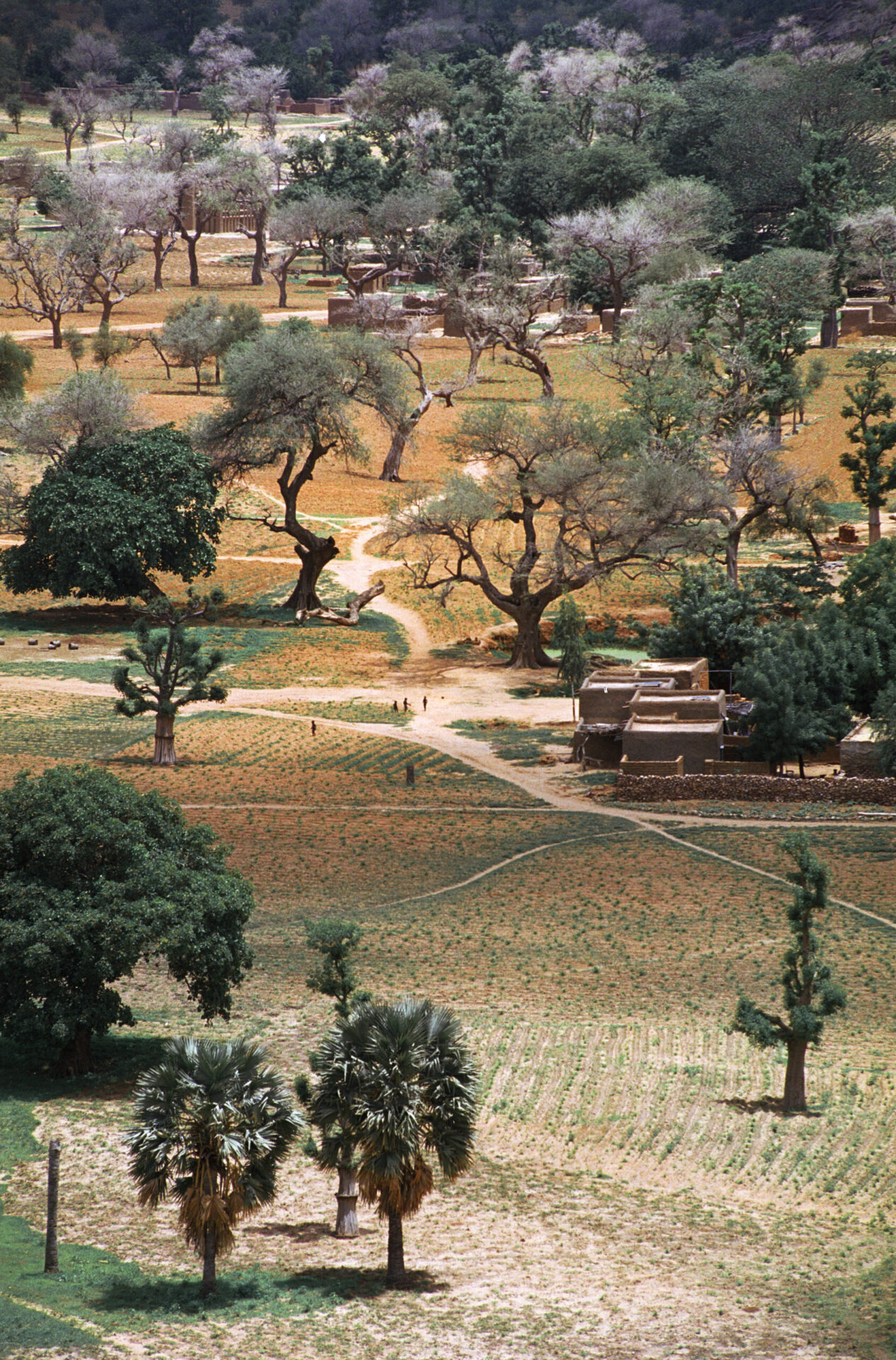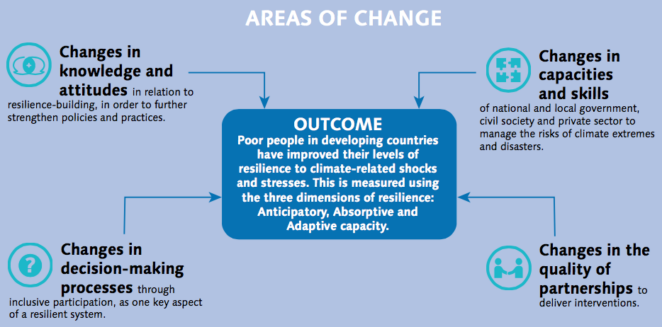Routes to resilience: insights from BRACED year 1

Introduction
BRACED projects cover a wide range of issues, from securing, servicing and promoting trans-border livestock mobility across the Sahel, to sharing skills and technology to improve the uptake of climate information in Ethiopia, to supporting smallholder farmers in Nepal to take advantage of economic opportunities and investments in climate-smart technologies. Furthermore, each BRACED project uses different intervention strategies and are being implemented in different climatic and operating contexts.
This report*identifies emerging themes, challenges and draws broader lessons about changes in resilience, how these can be understood and the factors shaping them.
Specific reflections, lessons and recommendations on monitoring and results reporting can be found in the companion report, ’Routes to resilience: lessons from monitoring BRACED’, which examines a related question: ‘What lessons have we learnt from the monitoring and results reporting efforts to date in BRACED?’ This reflection paper reflects on the M&E framework itself and the experiences of the Knowledge Manager in rolling out the framework and testing it for the first time through the year 1 project- to programme-reporting process followed in order to produce this synthesis report.
*Download the full text from the right-hand column. A short background to M&E in BRACED and summaries of the lessons learnt so far and recommendations moving forward are provided below; please see the full text for much more detail. A summary of the full report can be found here.

Key Messages (abridged)
Key message 1: Accessing and using weather and climate information is a critical element in building anticipatory, absorptive and adaptive capacities.To be successful, projects need to overcome potential challenges and bias towards prioritising localised short-term climate information. More support should be offered to implementing partners (IPs) and communities in building bridges between the seemingly easier use of near-term information and the more challenging use of longer-term information.
Key message 2: Achieving meaningful resilience outcomes requires knowledge, skills and capacities that go beyond the expertise of a particular Implementing Partner.Effective partnerships are a critical component of resilience-building programmes in order to draw on each other’s expertise, knowledge, experience and resources and to join forces for common goals as much as possible. Identifying the ‘right’ combination of partners is as important as the design and implementation of project activities. Even when knowledge, financial means and a supportive (governance) environment are often still lacking, IPs can sometimes produce creative, affordable and applicable technologies and solutions through networking and partnerships.
Key message 3: The starting point for enhancing individuals’ resilience is recognising and addressing social exclusion and gender inequality.While improvements in women’s participation in projects’ activities and access to resources are fundamental steps to take, they do not in themselves change power relations, and therefore may not translate into inclusive decision-making.
Key message 4: Building anticipatory and absorptive capacity to deal with current risks and threats is the first step for communities that are highly vulnerable to climate change.As BRACED projects continue in years 2 and 3, it will be important to think about how anticipatory and absorptive capacities can be developed in ways that provide a solid foundation for building adaptive capacity in the longer term. Understanding how resilience capacities interrelate – and revisiting whether it is more challenging to build adaptive capacity in the lifespan of a BRACED project – will be a key insight to inform theories for building community-level resilience on the ground.
Key message 5: While resilience-building interventions have building capacity to manage shocks and stresses as a primary objective, addressing and dealing with the socioeconomic and political dimensions of resilience-building are equally important.Writing operational risks away into an assumption column is not enough. The operational challenges of working in complex settings not only call for more pragmatic project designs and time frames, but also for exploring how links to other programmes addressing issues, such as peacebuilding and governance reforms, are necessary prerequisites for climate resilience programmes.
Key message 6: While resilience-building projects focus on building anticipatory, absorptive and adaptive capacity to shocks and stresses, in practice resilience-building programmes seem to be, at their core, ‘good’ development projects with ‘tweaks’.BRACED has come a long way in conceptualising and operationalising resilience in practice. IPs have also developed tailored indices and established baselines in order to measure progress and achievements. Understanding the factors that constitute the resilience of particular households is the starting point for devising, deploying and implementing resilience-building strategies. Evidence and emerging lessons to date highlights that BRACED routes to resilience are underpinned by development programming that explicitly takes climate shocks and stresses into account and builds stakeholders’ capacity to manage climate and disaster risk. While there is evidence that such approaches require in-depth assessments and analysis of stakeholders’ vulnerabilities and capacities, it is difficult to identify – from year 1 reports – how such approaches translate into a ‘different’ set of activities that go beyond ‘good’ development work and risk management approaches.
A detailed analysis of BRACED pathways to resilience and lessons learnt can be found in section 3 of the full text. A detailed analysis of themes and lessons learnt about BRACED outcomes can be found in section 4. And a detailed analysis of contextual factors and emerging themes and lessons can be found in section 5.

Recommendations (abridged)
BRACED presents a unique opportunity to integrate climate services into resilience programming. To achieve this, Implementing Partners (IPs) and the Knowledge Manager (KM) should further explore:
- The incentives and motivations behind the observed focus on near-term climate information. Is this driven by supply constraints or by a lack of demand?
- The new roles that IPs are playing as intermediaries/advisors between formal climate services and communities. How are these advisory functions perceived by the targeted users over time?
- The extent to which the limited reference to historical data or longer-term (decadal to multi-decadal) projections limits the adaptation components of BRACED projects.
Partnerships that have the potential to provide effective approaches to resilience-building are vital. During the remainder of BRACED, IPs and the KM should develop a better understanding about the following:
- The role of partnerships in resilience-building, and how best to ensure that partnerships are greater than the sum of their parts.There is a need to better understand how inter-organisational learning across partners translates into longer-term, positive impacts to increase community resilience.
- Establishing a means of credibly measuring, reviewing and documenting partnerships, in terms of both results and processes.
- Pay closer attention to the sociocultural aspects underpinning anticipatory, absorptive and adaptive capacities.This includes improving the analysis between transforming gender relations and the project’s theory of change for resilience-building.
- Document cases where inclusive decision-making takes place, in particular, examples illustrating the links between participation, voice and power.
- Further investigate and document the specific types of activities and strategies that should be integrated in resilience programming to support inclusive decision-making
In order to build a better understanding of how social exclusion and inequality can be addressed, IPs and the KM should:
- Pay closer attention to the sociocultural aspects underpinning anticipatory, absorptive and adaptive capacities.This includes improving the analysis between transforming gender relations and the project’s theory of change for resilience-building.
- Document cases where inclusive decision-making takes place, in particular, examples illustrating the links between participation, voice and power.
- Further investigate and document the specific types of activities and strategies that should be integrated in resilience programming to support inclusive decision-making.
To build a comprehensive understanding of resilience outcomes and inform future resilience theory, programme design and implementation, IPs and the KM should consider the following in the remainder of BRACED:
- In places where communities are prioritising enhancing anticipatory and absorptive capacity, investigate how these capacities are being builtin ways that provide a solid foundation for building adaptive capacity in the longer term.
- As shocks and stresses occur, document if and how people and communities are learning from these, and whether they rebuild in ways that reduce their future vulnerability.
- Investigate the role that community groups play in enhancing social capital, and thus enabling communities to cope with disaster events and strengthen their absorptive capacity.
- Document the level of integration, layering, timing and sequencing of the different capacity-building activitiesneeded to improve absorptive, adaptive and anticipatory capacities.
Improving programme design and implementation begins with the recognition and addressing of the ‘real-life’ challenges involved in implementing resilience-building projects and programmes. IPs and the KM should work closely together to develop an evidence base and better understanding of:
- The role of contingency fund mechanisms in resilience- building programmes,along with the extent to which they can support protecting resilience gains both in advance of, and in the face of shocks and stresses during the project cycle. The KM is already working with recipient IPs of the PHASE funding, on an evaluative learning piece with this as its focus.
- The opportunities and trade-offs of integrating climate disaster and peacebuilding goals as prerequisite criteria for resilience- building interventions, by engaging conflict experts.
- How to better integrate context analysis, beyond merely listing risks and assumptions, in programme design and M&E.The design and implementation of resilience-building programmes should include not only technical aspects, but also the sociocultural factors that influence attitudes, behaviour and practice.
There is a risk that BRACED may look like ‘old wine in new bottles’. In order to support effective project and programme design, implementation, M&E and future funding by the end of the programme, the KM along with IPs should identify and develop a set of criteria that identifies what makes resilience- building different in practice.
This document was written by Paula Silva Villanueva, Catherine Gould and Florence Pichon.
Research support was provided by Ghislaine Guiran and Jessica Roberts. The authors wish to acknowledge inputs from team members of the Knowledge Manager into specific sections of the report, in particular: Blane Harvey (use of climate and weather information); Roop Singh (BRACED climatic context); Emily Wilkinson (understanding BRACED outcomes); Elizabeth Carabine (Decentralisation); Virginie Le Mason (inclusive decision-making and women’s empowerment); and Katie Peters (BRACED in difficult environments). Their combined inputs have been critical for deepening the analysis of the findings.
The authors are also grateful to the project Implementing Partners, whose year 1 annual reports provided the data and basis for this work. The report has benefited from critical review from Robbie Gregorowski, Maarten van Aalst and Katie Peters of the Knowledge Manager and Derek Poate (external). The donor DFID have also provided their feedback and discussed how to ensure the findings are taken up and applied both within BRACED and other similar programmes. Finally, we thank Charlotte Rye and Clare Shaw of the Knowledge Manager for their support in the publication process.
Suggested citation:
Villanueva, P. S., Gould, C. and Pichon, F. (2016) Routes to resilience: insights from BRACED year 1. BRACED Report Building Resilience and Adaptation to Climate Extremes and Disasters (BRACED): London, UK
(0) Comments
There is no content